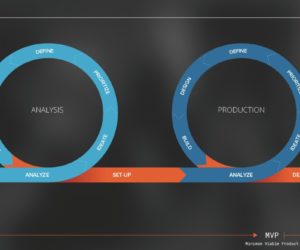I’d like to start off with a quick post lock-down observation before diving in this blog post’s subject – launching an e-commerce business. Sometime ago, I went out for a drink with friends after a few weeks of quarantine. Despite the social distancing, I had one of the most delicious beers in my life, with the fresh taste of freedom and an air of simpler times.
You’re probably wondering how this connects at all to e-commerce and this article. Well, that same night one of my friends, a CEO of an SME that sells local goods in tourist destinations posed a question worriedly,
“How can I launch a successful e-commerce business fast?”
Apparently this was a burning thought that had been recently keeping him up at night.
“The tourists are gone, Andrei! I need a new income streamline. I need an online store and I need it now. There has to be a secret.”
So, I explained to him that it only takes three sprints to get into an e-commerce business and become a pro.
And, since my friend isn’t an isolated case (most prospects I’ve spoken with in the past few weeks have the same concerns), I wanted to share my experience here.
The “sprints” I’ll be talking about, however, are a little different than the ones you’re probably thinking of.

I’ll be talking about the usual journey for an e-commerce business owner from the moment they decide to get into e-commerce to the point they become a benchmark for users and competitors. This process takes several years and involves testing phases, learning curves as well as multiple successes and failures.
We can split this process into three phases I call “sprints”, because they carry the sprint rationale: to listen, test and learn. Continuously listen, test and learn.
Sprint #1: Launching an E-commerce Business
For CEO’s, it all starts when an e-commerce plan is approved, a budget is allocated and a single point of contact is appointed – normally the IT professional who manages the server and configures the equipment, among other duties.
The Role of E-commerce
Truth is, no one can say if this new channel of selling is going to work – e-commerce is just one of many new tools companies have in their toolkit.
The Solution
Several options are available to those launching an e-commerce business such as Shopify, WordPress, WooCommerce, Wix, and more.
The Team
You’ll need someone with the technical skills and time available to set up an e-commerce site.
The Benefits
This approach requires minimal initial effort and can be implemented quickly. The documentation platforms for these solutions have lots of resources available and many consultants offering their services for each feature at competitive prices. There is a true “marketplace of expertise” out there where you can pay for “know-how”, execution and implementation of each solution or sub-sets of these solutions.
The Limitations
After the launch, the business quickly begins to feel constrained: their e-commerce site is nothing special, since everyone has the same store. Not to mention the fact that the back-end is increasingly complex. For instance, data is migrated manually and inventory can only be done outside the solution with an exported Excel spreadsheet then a manual import. The same goes for order tracking and billing.
With this kind of tech solution, the system has to be built around the features offered by the solution. You must consistently make improvements by performing manual tasks parallel to the platform. In addition, this means you should consistently train your employees on the new manual processes that pop up each time you make an improvement or update.
Our CEO soon discovers that while the start-up cost is low, the price for all these new “compensation” jobs can add up quickly.
It’s true that the time-to-market for e-commerce is very fast. However, the team that pops-up around a simple, rigid solution can turn out to be quite expensive.
Once another listen, test, and learn cycle finished, something had to be done.
Sprint #2: Becoming a Pro
Sprint #1 enabled our CEO to confirm that the e-commerce business works, to check if there is a demand for their products and observe their customers’ purchasing habits. A “sprint” for observing, testing, and learning develop optimal internal processes. Processes that didn’t exist before the e-commerce site went live.
New teams are formed to get products and campaigns ready; they now manage the supply chain and order logistics, returns and mistakes reported by unsatisfied customers.
Now is the time to get serious and optimize costs to grow your sales.
The Role of E-commerce
In Sprint #1, e-commerce was just another tool, one that wasn’t necessarily taken seriously by everyone at the company. Now, it has become an essential part of the company’s lifecycle. This tool becomes an increasingly important part of the strategic decision-making process, to the point that the tool itself can sway major decisions to fit within the solution’s constraints.
The Solutions
Solutions like Symfony, Magento and OpenCart are considered. All these are open source. And they use PHP.
The Team
The IT expert from Sprint #1 becomes the CTO and the decision to make e-commerce a major part of the business leads the company to form a department with a dedicated team. There are several ways this can go: the CTO might start with three or four students or the team might be outsourced. What is certain is that new expertise is needed: from Magento development to UX/UI design, not to mention a coordinator for this new team of specialists. And teams need a budget, of course.
The Benefits
The major benefits of these solutions are the company’s simplified internal processes and the automation of many tasks that used to be done manually through full integration with the ERP layer. Freed from Excel at last!
Operational employees get a breath of fresh air, with greater flexibility when implementing new features and greater freedom in adapting the tool to the company’s process needs.
The Limitations
Here is a fact: the more e-commerce brings in, the more people want, the more customers demand and the more complex internal requirements become.
Little by little, you start seeing security problems cropping-up, not to mention all the things required to staying compliant with the GDPR. In time, site performance becomes is disappointing as well, and the customers are saying it out loud. And to complete the picture, sales growth is lagging considerably; and it might be because the competition just does it better (they have switched to a fully customized solution years back).
Solutions like Magento start to struggle when sales top 1,000 per day or the number of catalog items surpasses 50,000.
These solutions can’t really stand-up in the long run since they are not scalable.
Sprint #2 is useful for structuring internal processes, collecting data about customer purchasing behavior, and testing the business plan. Yet another listen, test and learn phase.
After one or two years, it is time to transition to a solution that fits these requirements and delivers a new experience, making it possible to continue growing.
Sprint #3: Pursuing Excellence
Understanding your positioning with respect to the competition and your customers’ unmet needs leads to the desire to excel, to be at the leading edge and create that wow factor.
In addition, e-commerce develops in parallel with the digitization of the rest of the company. In fact, it often drives it. Having arrived at Sprint #3, our CEO knows that digitization has become the cornerstone of their company’s architecture, with each department a simple cluster in the omnipresent digital layer.
The Role of E-commerce
There are two possible scenarios, with a different role for e-commerce in each:
- Pure players: these are the companies that evolve in step with the tool (e.g. Amazon). They perform to an extremely high standard when it comes to the last mile, communicating with customers and personalizing all the services they offer. Unique features ensure that their company is perceived as better than the rest of the market.
- Large companies with SaaS solutions: these are the companies who use off-the-shelf CRM and ERP solutions and who would like to adopt customized e-commerce solutions that will help them stand out from their competitors.
In this Sprint, there is no real distinction between e-commerce and how the company functions as a whole. The digital layer is a vital part of how the other departments structure themselves: every aspect of the business is completely customized and they are structured to align with the digital strategy.
The Solutions
Companies often arrive at Sprint #3 after deciding to rebuild everything from the ground up. They have decided to completely abandon the old solution that now seems to be out-of-date.
This is when our CEO turns to a custom solution that is 100% .NET or JAVA on the back-end and single page application on the front-end, with standalone business domains and often microservices architecture. The ultimate in e-commerce.
The Team
Having the latest technology requires strong expertise, however. The tech department is doing more than just developing the features requested by the operational departments. The team of developers, testers, coordinators and product owners is working closely with the production teams and the people in charge of the warehouse, logistics, the supply chain, transportation, marketing, order management and shipping.
The Benefits
The flows of products and data are quite seamless. The goal of the tech team in each sprint is to understand who their customers are and how they think so they can keep providing an excellent experience. Every single sprint. Their decisions are data-driven, with data and design experts working on the team to analyze how users interact with the platform and to track the results of A/B testing, analytics, user flow analysis and more.
Data analysis provides information that the teams can use to offer new features that improve the user experience and their own workflows: for instance, automating order creation, tracking packages, sequencing the steps in the payment phase, and so on.
One of the most common mistakes I’ve seen is starting directly with Sprint #3 and completely skipping Sprint #1 and Sprint #2. Usually, what happens is that a new digital director is brought in and asked to take on this task. And the new guy/lady has no time to lose. Cutting some corners seems like a great idea at first. Until it isn’t.
A truly flexible e-commerce solution is only possible in an environment that is already highly digitized, with departments that are all familiar with e-commerce and comfortable wearing two hats: as experts in the company’s core business and experts in digitization.
There is a natural process for e-commerce development. A process of listening, testing, and learning in each phase. Going through these three Sprints is both normal and necessary.
To launch a successful e-commerce business, you have to start by exploring and learning about digital solutions. With these simple solutions you can try out the tool and collect data to help you understand your customers and their behavior. You will gradually reach a state of maturity in your e-commerce model and you will naturally transition to Sprint #2 and Sprint #3 sooner or later, with the same pace as your company is growing.
The North Star for the CEO of your e-commerce business is always the cost/benefit ratio. This ration is continuously oscillating within a reasonable range. It’s true that for a while the ratio will be less than favorable, but the potential is great enough that the desire for growth will win out. Monitoring this ration is vital for planning its refactoring at the right cost.
I have noticed that excellence in this model comes when our CTO does two things:
- Carefully analyzes and anticipates how and when to move from one Sprint to the next. When does the cost of sticking with one solution exceed the amount it would take to abandon it and move to a better solution
- Continuously demonstrates to the rest of the company that the decision paid off. Having a CTO who knows how to communicate and get people on board is the best way to make your e-commerce venture a success.
Are you looking to get started in eCommerce? Maybe you need a business boost to establish yourself as an industry leader? Contact us, speak with one of our eCommerce consultants & tell us about your project today.









